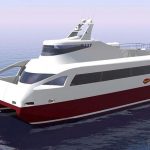If you’re holidaying anywhere between Zadar and Split, Knin is one of the best day trips Dalmatia has to offer.
- Welcome to Knin Croatia!
- What to do in Knin? 5 best things to do in Knin
- Knin Fortress
- 5 things you (maybe) didn’t know about Knin
- Where is Knin Croatia? Knin Map
- Accommodation in Knin: Where to stay, Knin Hotels, Camping
- Where to eat?
- Top day trips
- Knin Weather
- How to get to Knin and get around
Welcome to Knin Croatia!
Prominently placed atop Spas hill, a famous fortress today surrounds the Old City of Knin. Indeed, Knin Fortress is one of the most recognisable landmarks in Croatia. It’s unique, protecting the former seat of Croatian kings. Everyone can spot Knin Fortress from a picture. And, everyone knows of Knin. Yet, far fewer have ever been.
There’s a widespread misconception about the great city. Generally, it’s spoken of in the past tense, its significance considered to belong there. That is untrue. Yes, Knin is a wonderful place for history buffs who come. But, the appeal of Knin extends far beyond its past.

This is a diverse place, full of culture and cuisine as well as history and heritage. Located near the spring of the Krka river, waterfalls and rivers, hills and mountains surround Knin. Once known as ‘The Gateway to Dalmatia’, today it is also the gateway to Dinara Nature Park and Dinara mountain. Furthermore, the epic Krka National Park is just a few kilometres away.
Located around 50km from Šibenik, near the borders of Bosnia, Lika and Dalmatia, Knin is so accessible, you’d think everyone whose heard of Knin might have already visited. But, many haven’t. Maybe they’re not aware of all the reasons why Knin is one of Dalmatia’s greatest day trips, or perfect for a weekend break? We’ll try to set the record straight here, by showing just a little of what Knin has to offer.

What to do in Knin? 5 best things to do in Knin
1) Knin Fortress

Without a doubt, the number one star attraction in Knin is Knin Fortress. In fact, so significant is the appeal of the former Knin castle, we’ve dedicated an independent section to it. (see immediately below.)
2) Dinara Mountain and Dinara Nature Park

Against a backdrop dominated by the mountain, in Knin there’s no escaping Dinara. Even so, the view from afar doesn’t give the full story. While you may know this is Croatia’s highest peak, there’s much more to tell. In fact, the mountain is just one part of the huge Dinara Nature Park. From hiking the hills to walking the river valleys, the park has much to offer. Along some routes, you see traditional life, culture and heritage. Furthermore, Croatia’s earliest church with a bell tower is here. Also, the source of the Cetina river. If you want to find out more about this fabulous park and mountain, then read our detailed guide.
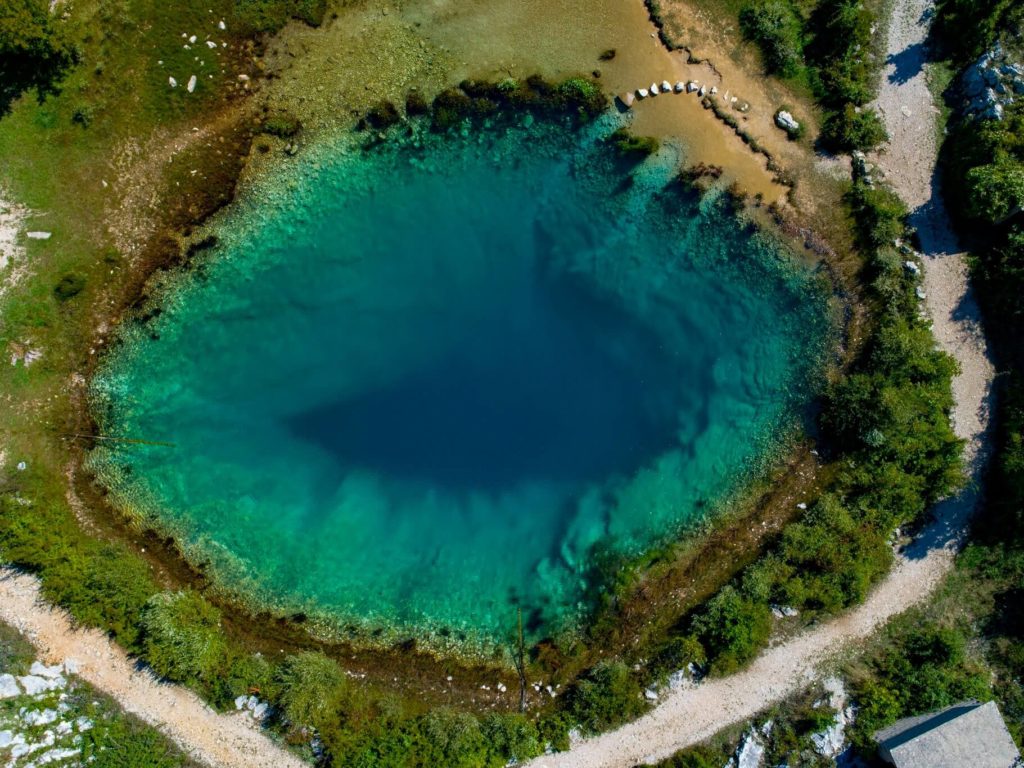
3) Discover the waterfalls, hidden lakes and 7 rivers of Knin

If you think the only incredible water to enjoy in Croatia is the Adriatic, then you’d be wrong. Indeed, heading inland from your beachside holiday can be one of the most rewarding trips you’ll make. Both Plitvice Lakes and Krka National Parks thrill visitors with their cascading waterfalls. Accordingly, they are two of Croatia’s most popular National Parks. Indeed, located less than 15km from Šibenik, Krka National Park is very accessible to those staying beachside. But, the story of the Krka river which feeds this beauty spot is located further inland. Both the river and the waterfalls begin at the foot of Dinara near Knin.
The 7 rivers of Knin

1) River Krka

Around 15km east of Knin, between the villages of Polača and Đurići, the Krčić river begins its life. In fact, the first of the Knin waterfalls is right here. Also here, the first evidence of people harnessing the near 90 metres this water eventually drops. Specifically, an old, abandoned mill lies next to the first tiny fall. (In contrast, the major falls on the lower course all power hydroelectric stations).
After 400 more metres, a picturesque pool where locals swim in warmer months. Although, quite often, this Krčić canyon dries up in summer. Accordingly, river ramblers are best advised to come in spring or late autumn.
Krčić waterfall
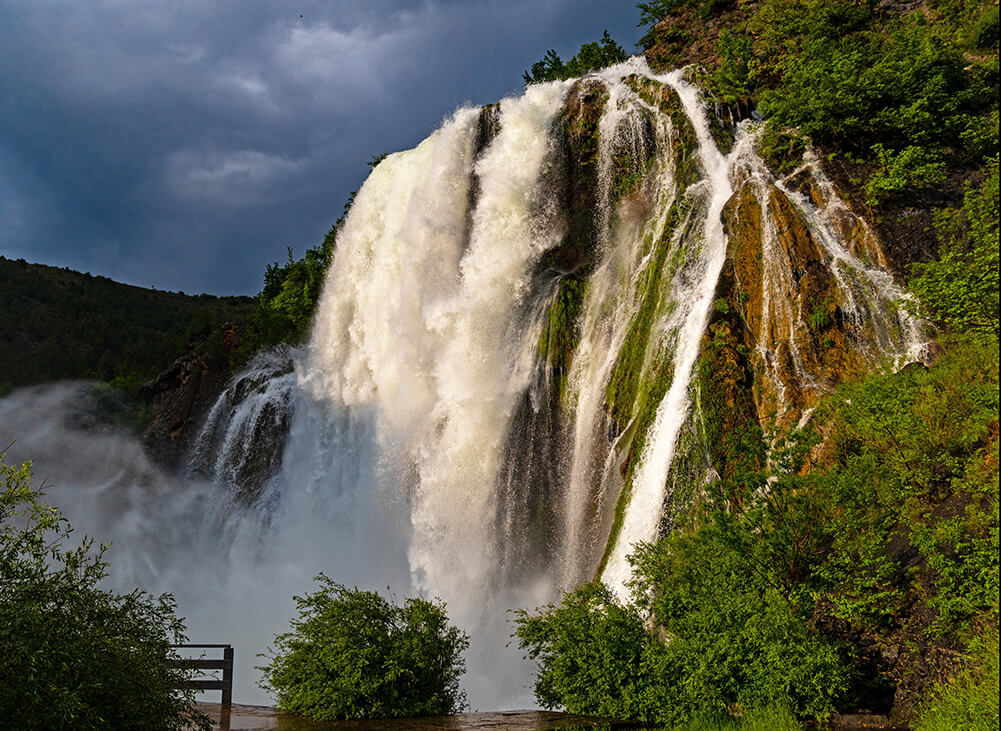
At the Krčić waterfall, Krčić drops epically into the karst valley of Knin. Beneath the first 22 metre fall, a spring, hidden by the white spray. At this point, the 73km Krka river begins. Between the two falls here, a bridge. Not only is it perfect for viewing the cascades, but also for taking photos.

2) River Kosovčica

Near the village of Riđane, Biskupija, water from several springs drops into the Kosovo karst field. Down in the valley, they form the Kosovčica river. Compared to the upper course of the Krka, this 15km river never dries up. Although, in summer, its flow becomes weak. However, in late autumn and spring, it swells and floods the lower field, before flowing into the Krka. In fact, this flooding feeds two sets of Knin’s hidden lakes, Šarena and Burum.
3) River Orašnica

Between the confluence of the Kosovčica and Krka and Knin Fortress, the Orašnica river joins the Krka. Again, like the Kosovčica, this 5km river never dries up. Actually, it used to be prone to flooding, putting at risk the south of the city centre. For this reason, they moved the confluence further upstream and installed concrete walls. Subsequently, the former flood areas dried up and mosquito numbers decreased.
4) River Butižnica
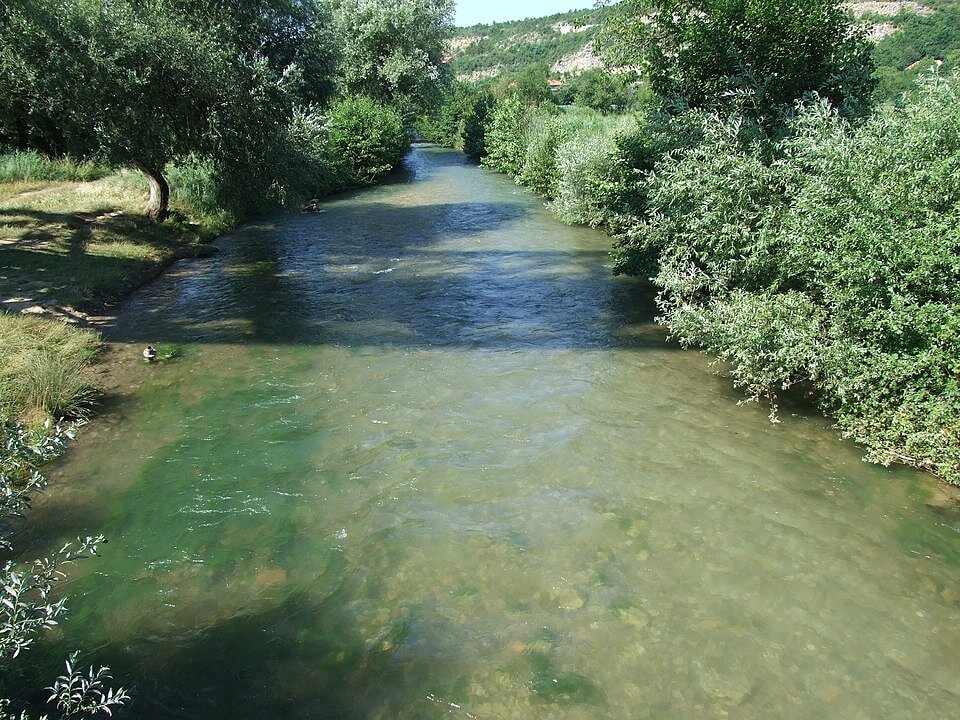
Around 37km north of Knin, the village of Kaldrma is today almost forgotten. Previously, it thrived, linked to Knin in 1902 by an Austro-Hungarian narrow-gauge railway.
Eventually, the narrow-gauge railways were either upgraded or retired. However, Kaldrma kept its narrow gauge line to Drvar until 1978! Today, the only thing that runs between Kaldrma and Knin is the Butižnica river.

Around 50 metres from Kaldrma railway station is the source of the Butižnica, a small lake. Interestingly, some of its waters also feed the Una river. Consequently, this one tiny lake actually flows into both the Black Sea and the Adriatic. To the latter, it does so after the 39-kilometre Butižnica meets the Krka. Not only is Butižnica the biggest tributary of Krka, but also two more Knin rivers run into it. Namely, the Radljevac and the Marčinkovac. Furthermore, its flow is so strong, at one point it forms the Butižnica lake. In summer, it’s a popular place for swimming.
5) River Radljevac

The Radljevac begins its life in the village of Plavno. Along its 20km course to the Butižnica, remnants of several old mills that once ran from it. Today, the river dries in summer months. Previously, in the same period, children used to swim in it.
6) River Marčinkovac

The source of the Marčinkovac is Šimića spring, from which Knin gets its drinking water. While its birthplace is simply identified, the river actually runs a short but complicated route. No sooner has the river begun, than it splits in two. Actually, the diversion is man-made, providing water for irrigation and watermills. Eventually, they reconverge, before splitting again and flowing separately into the Butižnica.
7) River Zrmanja

The epic 69km Zrmanja is just a guest in Knin. In fact, Zrmanja begins its life in nearby Zadar County. Along the county borders, not far from Radljevac village, it cuts into the municipality of Knin.

Knin’s hidden lakes

If you want to discover Knin’s hidden lakes, then prepare for a walk into the wild. While these beauty spots are enjoyed by locals and fishermen, they are not arranged like picnic areas. Therefore, think about wearing appropriate footwear. Without a doubt, it’s worthwhile choosing walking boots, even during warm days. Not least for the glorious nature that unfolds.
Šarena lakes (Šarena jezera)

There’s really something rather otherworldly about Šarene lakes. Firstly, not all of these five neighbouring pools are lakes. In fact, three are lakes, while two are wellsprings. But, that’s not the only difference. Curiously, the largest pool is largely free of vegetation. Probably a result of the perpetual water flow that feeds it. Dissimilar, the surface of the others offer shades of green due to the plants living there. Although, this is not the reason for their name – ‘Colourful’ lakes, šareni meaning colourful. Actually, their colour change in response to sunrise and sunset is the reason. Interestingly, one of the most popularly caught fish here is carp which, in Croatian, is called šaran. Although appearing similar to non-native speakers, these words – šaran and šareni – are actually unrelated.
Burumska lakes (Burumska jezera)

Alongside the D1 road from Sinj and Split are the Burumske lakes. Actually, they’re only around a kilometre from the centre of town, to the east. Both walkers and fishermen enjoy these two neighbours.
Lake Golubić (Golubićko jezero)

Above Knin, to the north by 8km, Golubić is an artificial lake. Actually, the hydroelectric plant on the river Butišnica forms it. Not only do people fish here, but also there’s a popular, family bike trail running here from Knin.
4) Find authentic and traditional Dalmatia in the hinterland

Generally, Knin cuisine is continental. While these days, you can get sea fish and calamari in Knin restaurants, there are better choices. Furthermore, trying and buying traditional food and drinks is definitely one of the best things to do in Knin. Not only is it educational and delicious, but also it helps preserve traditional ways of life. Subsequently, it actually safeguards the beautiful natural landscape surrounding.
Around the whole area, grasslands are kept prettily trimmed by grazing animals. In general, sheep. But, goats and cows too. Also, Knin’s fishermen help preserve the river areas. So too, the hunters in the countryside. In combination, they help maintain the natural beauty of the region. Its a landscape nurtured by such pursuits over thousands of years.

Knin Market
Without question, if you have chance to go to Knin’s new market, then go. Not only will you get to try lots of different traditional produce, but also you’ll meet the producers. Important to realize, there are literally hundreds of small, family farms in the region. On Saturdays especially, many make their way to Knin market. For example, you might meet there OPG Tica from Markovac, who make fresh cheese and ‘Sir iz mišine’. Furthermore, their (and many others) produce is completely free of additives and preservatives.
Sir iz mišine

Previously, traditional life in these mountains included semi-nomadic farming of sheep. In truth, the yield of milk from these animals is not great. Also, you can’t take it year-round – sometimes the young-born lambs need it more. Therefore, when available, they seized the opportunity. Some milk became cheese, preserved in sheepskin – sir iz mišine. Not only is this a traditional product of the Dalmatian hinterland, but also its origins go back to the Thracians and Illyrians. Consequently, the method of this unique cheese’s production has not changed for thousands of years.
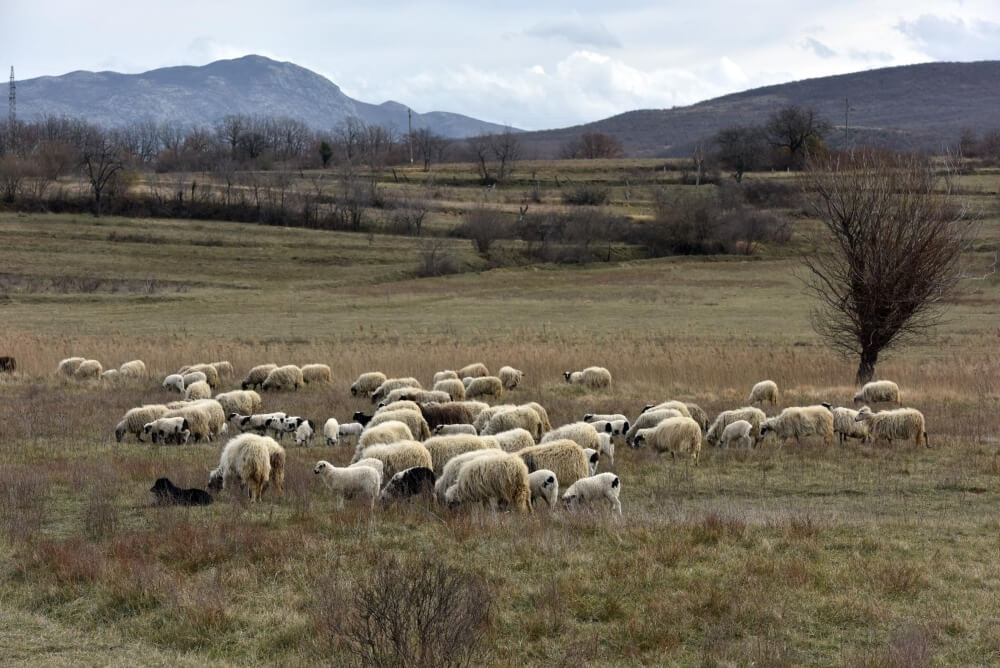
In preparation, they inflate and shave a sheepskin. Afterward, it’s salted and for 15 to 30 days it dries. Before use, it soaks in cold water, then rinsed. Thereafter, fresh cheese is layered into the skin, interspersed with thin layers of sea salt. Above all, they ensure no air is in the sack when sealed. Over two or three months the cheese matures, the producer turning the sack daily. Markedly, the sack preservation method imparts a distinct taste and texture to the cheese. Previously, the Dalmatian hinterland made 15 tonnes of sir iz mišine annually. Today, only 3 tonnes, mostly around the areas of Knin and Drniš.
Meet the producers
If you can’t make it to Knin market, then you can visit some Knin producers at work. Not only can you try their produce, but also you’ll see how it’s made.
OPG Markoš

Not only do OPG Markoš in Pađane have all kind of cheeses, but also they make basa. It’s unique to this area of Dalmatia and Lika. In detail, basa is kind of like cream cheese, veryrefreshing. Also, they make sir iz mišine. But, from cow’s milk, which is quite rare.
Burnum winery (Vinarija Burnum)

Around the village of Vrbnik near Knin, Vinarija Burnum grow grapes and almonds. In order to, they irrigate their fields with water from underground wells. Both a white cuvée and a red cuvée stem from their efforts. Go try them at the winery. You’ll taste a combination of chardonnay, viognier, pošip and maraština in the white. You’ll meet a combination of merlot, cabernet sauvignon and babić in the red.
Kninsko pivo

At Knin’s first craft beer brewery, they make excellent pilsner and pale ale. Actually, you can tell if you’re in a good Knin bar or restaurant by whether or not they sell this.
5) Enjoy beautiful, untouched nature at your own pace

Both river valleys and mountain slopes surround you in Knin. In truth, although it’s a city, most of Knin is pristine, untouched nature. Indeed, much of the landscape has looked the same for millennia. If fresh air and the great outdoors are your thing, then this is the place for you. Certainly, there are many ways to experience nature here, from thrilling activities to gentle enjoyment.
Hiking and walking

Overall, the very best things to see in Knin all involve walking. But, that doesn’t mean they’re inaccessible or taxing. Both Knin Fortress and the riverbanks around the town involve only a relaxed stroll.
But, if you’re looking for a challenge, there’s nowhere better than Dinara mountain. Not only do various hikes offer a range of topography, but also the views are spectacular. Import to realize, Dinara Nature Park is much, much more than just this one mountain. In fact, the Nature Park is vast. Accordingly, it has multiple hiking and walking routes. If you want to learn more, then read our detailed guide.
Cycling

Either cycle slowly by the river or make your way into the mountains. Indeed, Knin has its own bicycling club committed to constructing routes. Not only do they organise competitions, but they also draw cyclists from all over. If you want to find out more about their mountain biking trails, then contact Adrion Orus bike club here. Also, they rent e-bikes. If you want to see some of the cycling routes of Knin, then look here.
Canoeing and rafting
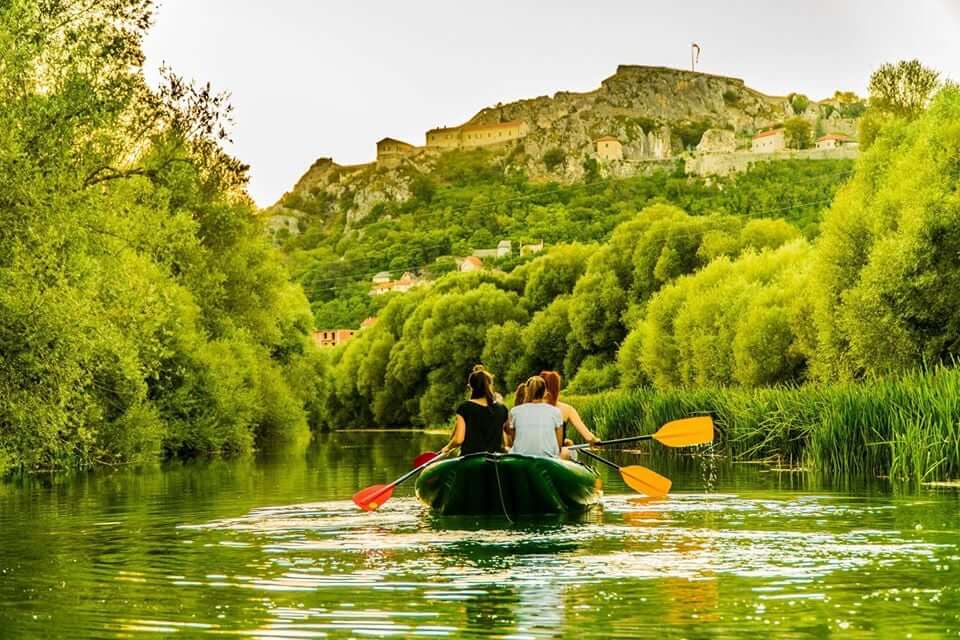
Either by kayak or canoe, floating down the river is a great way to get up close to nature. Furthermore, the Fortress, as always, gives an awesome backdrop. Ask Ekološka udruga ‘Krka’ Knin about hiring a kayak or canoe. Also, there’s the option of enjoying the Krka seated comfortably on King Zvonimir raft. In particular, this option opens up the river to young children in groups. Also, you can speak with Marunuša about eco activities.
Horse riding

If you’d prefer to let someone else do the walking for you, then politely ask a horse. Not only can Udruga Grabarije-Knin take you through fields, but also by the rivers and waterfalls. Furthermore, they have over 10 years experience of working with children and children with special needs. Consequently, the range of persons who can enjoy the horses is huge.

Fishing and hunting

These days, you can enjoy calamari and sea fish in Knin restaurants. But, that wasn’t always the case. In fact, travel through the mountains was once much more of an ordeal than it is today. As a result, the local menu relied more on river fish and wild meats. Not only does this traditional menu continue, but also the activities that supply it. If you want to find out about fishing here, then follow this link. Not only is ŠRD ‘Krka’ – Knin‘s brilliant website available in English, but also it tells you everything.
Knin Fortress

It’s impossible to convey the size and impressive nature of Knin Fortress using photos and words. Just go. It’s the only way to get the true experience. Not only are the views amazing, but also the sheer scale of the construction. Epic.
The Croats started building Knin Fortress in the 9th century. Century. As the capital of the kingdom, invaders attacked it many times. Over the centuries, it was conquered, added to, demolished and rebuilt by Hungarians, Turks, Venetians, the French and Austrians. But, also, Croatian medieval nobles played their part.
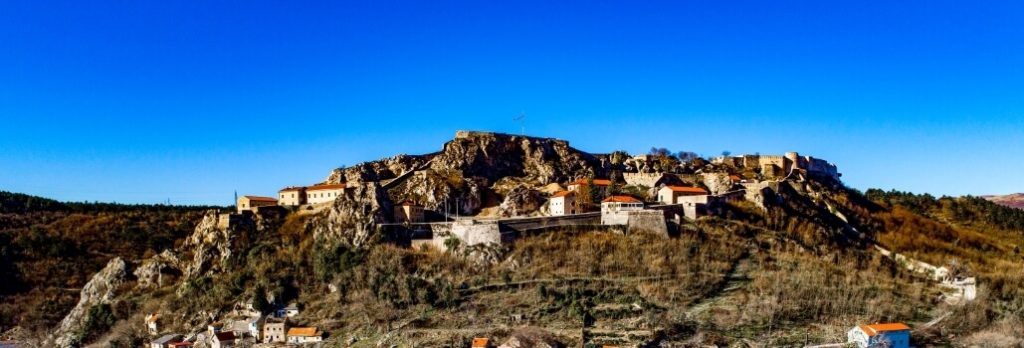
Vital statistics of Knin Fortress
The monumental Knin Fortress sits at an altitude of 342 metres. In detail, Knin Fortress is 470 metres long, 110 metres wide and occupies an incredible 123,143 square meters. As such, it is the second-largest historical fortress in Europe. Added to over many years, it has several distinct sections.
Knin Castle

The oldest part of Knin Fortress is the upper section, Knin castle (Kaštel Knin). Knin castle was built in the 9th century. It was the seat of the old Croatian state and its kings. In fact, some four Croatian kings sat here in succession.

A castle surrounded by Knin Fortress
Today, you approach Knin Fortress through Loredan’s gate, built in the 18th century. It connects to the round tower by a rampart that protects Knin Fortress entrance. Thereafter, you enter the fortress over a drawbridge.
To the right, a 17th century watchtower. Today, it is a rather marvellous restaurant. To the left, the Pisani bastion. Several buildings and different stages of construction exist within the walls. So too, walls built to house canons, watchtowers, ramparts and roads. Read about their various former uses as you walk.
5 things you (maybe) didn’t know about the city
1) Knin has a fascinating and complicated history, strongly associated with Croatian identity

Following the collapse of the Roman empire, the entire Balkan peninsula was segregated into a series of kingdoms. During the Middle Ages, the first Kingdom of Croatia was established. Within this period, Knin rose in status from regional capital to capital of the kingdom.
Biskupija

The village of Biskupija, just 7km south of Knin, was the religious and cultural centre of the medieval kingdom. Not only did the Bishop of Knin reside here, but also he served as the Bishop of Croatia between 1040 and 1522. Accordingly, Biskupija is an incredibly important archaeological site of Croatian national history. Both the art and writings found here help form the foundations of Croatian national identity. Furthermore, the earliest representation of the Virgin Mary in Croatian art was found here.

The Middle Ages saw a growth in the power of entities that sought to exercise control over the region. At times within this period, Knin was allied with, fought against, or was under the control of several competing kingdoms, republics, or empires. Among them, Venice, Hungary and Bosnia. Today, many regard the Middle Ages to have ended with the rise of the vast Ottoman Empire. Indeed, the Ottomans swept through the Balkans and occupied much of the territory for hundreds of years. In Knin, they seized the city in 1522 and remained there until 1688. Thereafter, a century of Venetian control, then French, then Austrian.
Lujo Marun aka Father Stjepan Alojzije and Croatia’s first museum of archaeology in Knin

Actually, the priest pictured next to Borna’s sarcophagus (above) is no less than the founder of Croatian archaeology. Namely, he is Lujo Marun, born in Skradin in 1857. Later, he became known as Father Stjepan Alojzije. While serving as parish assistant in Drniš, he did his first excavations. In 1886 he led excavations at the Basilica of St. Mary in Biskupija.
In 1893, he founded the first archaeological museum in Croatia, the Museum of Croatian Archaeological Monuments in Knin. Under threat of damage in World War II, it moved to Sinj, then Klis. In hindsight, it is perhaps less understandable that the museum thereafter did not return to Knin. Instead, in 1978 it went to Split. However, the suppression of national identity was a concerted effort in Communist times. Although the permanent theft from Knin of its greatest historical assets does today seem unjust, it’s not all bad news. The Museum of Croatian Archaeological Monuments is now in a wonderful, purpose-built home. Furthermore, its coastal location means more visitors see it.

Lujo Marun’s story did not end with the museum. Actually, in 1898 he managed to save Knin Fortress. All but forgotten, its stone was at certain risk of classic Balkan ‘recycling’. So, he bought the fortress and its fifteen buildings for 4,000 forints, preserved them and built its museum.
2) The city was one of the main transport hubs of the region
You can see evidence of Knin’s importance as a city throughout history in its fascinating infrastructure. Indeed, in Knin today, you can still walk the remains of an untouched Roman road! While briefly under French occupation, Napoleon’s men began an ambitious road connecting north Dalmatia to the south through Knin. In detail, it ran Zadar – Knin – Sinj – Trilj – Vrgorac – Metković.
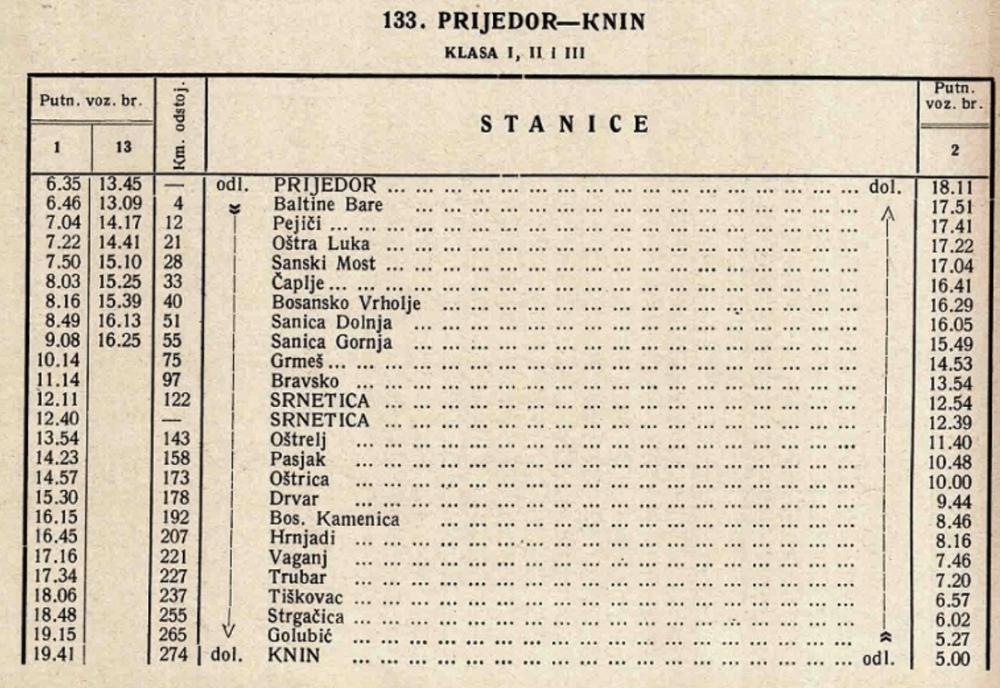
As has been noted (in the River Butižnica section, above), Knin got its Austro-Hungarian narrow-gauge railway in 1902. Although at first constructed for industry, things soon changed. Firstly, the train started to deliver mail. Secondly, from 1912, sections of the narrow-gauge began transporting troops during wartime. Subsequently, the lines were expanded and passengers accommodated. Between the end of the First World War and 1948, you could travel by narrow gauge from Knin to Prijedor, then on to Banja Luka. Also, from Knin to Jajce.

To the west, rail has connected Knin to both Split and Šibenik since 1888. To the north, Knin received a standard gauge connection to Rijeka and Zagreb via Oštarije in 1925. After 1948, a standard gauge line running Knin-Bihac-Novi Grad replaced the single gauge. Indeed, for a time, this was the major rail route connecting Dalmatia with Zagreb, Osijek and Belgrade.
3) Many different ethnic groups have lived here
The hill where Knin Fortress stands has held human occupation since the stone age. Correspondingly, many different ethnic groups have since lived here, sometimes simultaneously. Certainly, Illyrians once resided here, with Romans nearby (see below).
Fighting and war in Knin have several times affected the ethnic make-up of the city. In fact, while under Ottoman rule, most Croatians left. Thereafter, the Turks repopulated the city with others, including many from Bosnia. Within a very long and historic list, the most recent incidents greatly impacting the population make-up have been industrialisation, war in Knin during the 1990s and Croatia joining the EU.

Vlasi, Vlachs, Wallachians, Vlaj in Dalmatia and Croatia
One of the least-mentioned peoples to have inhabited Knin are the Vlachs, Wallachians, or Vlasi. In medieval times, this ethnically related group lived throughout much of the Balkan peninsula. In Dalmatia, they spoke the now-extinct Eastern Romance language called Dalmatian or Dalmatic. Certainly, we know from Croatian historical documents they were here and considered separate.
Specifically, at the last stand of Mladen II Šubić of Bribir – a Croatian and Bosnian ban based in Knin – his troops in Klis Fortress were recorded. In detail, records mention family soldiers, Vlachs and noble houses of the Poljica region.

Despite being indigenous (they are thought to have been of Thraco-Roman or Romanized Illyrian origin), in medieval times, ‘Vlach’ began to signify ‘stranger, foreigner.’ Although, these people also actually lived a traditional lifestyle of the region. Namely, across porous medieval borders, many would live a semi-nomadic existence, driving their sheep to pasture.

Localised etymology of Vlachs, Wallachians, Vlaj or Vlasi in Croatia
Over time, the Vlachs became assimilated into the local population. But, while the semi-nomadic existence died out, the words ‘vlah’ and ‘vlasi’ remained. Specifically, it became a name for those living rurally, away from the sea (where the Vlachs used to live). Furthermore, the term became a derogatory one, describing a shepherd class. Indeed, much to the confusion of visitors, the words ‘čoban’ (shepherd) and ‘vlaj’ are still used here in a derogatory way. (In Western Europe, ‘shepherd’ is far from a derogatory term. In fact, it is a respected occupation. Not only does the shepherd put food on your family’s table, but also he is often a landowner).

Today, the term ‘vlasi’ is used across Croatia, Bosnia and Serbia to describe incredibly different people. Usually, the term distinguishes social class, etiquette, place of origin or means ‘outsiders, newcomers’. Furthermore, the same root of the word is used across all Europe with the exact same meaning. For example, ‘Welsh’ or, in Belgium, ‘Walloons’.
4) The largest Roman amphitheatre in Dalmatia was built in the Roman town of Burnum near here

Between the borders of Illyricum provinces Dalmatia and Liburnia, the Romans built Burnum. Chiefly, they constructed it as a military camp. Indeed, it originally housed the 20th Legion of the Roman Army.

In order to train the troops, they built an amphitheatre. Not only is Burnum amphitheatre the largest Roman amphitheatre in Dalmatia, but also it is the only military amphitheatre in Croatia. Furthermore, it is incredibly atmospheric. More hidden here, yet no less remarkable is the Plavno polje – Burnum aqueduct. Not only is it a considerable 32.6 kilometres long, but also it runs completely underground. Alongside the river Krka, near the village of Ivoševci, Burnum is 18km west of Knin.
5) Krka National Park is closer than you think

Certainly, the most popular image of Krka National Park is Skradinski buk. Without a doubt, this gushing waterfall on the river’s lower course is impressive. So much so, that many visitors fail to venture to the park’s north to see more. In fact, Krka National Park is vast. Actually, it begins in the north just a couple of kilometres from Knin, at Bilušića waterfall. Thereafter, three more of the park’s waterfalls follow in very quick succession. Both Brljan and Rosnjak are extremely pretty. By comparison, Bilušića and Manojlovac waterfalls are simply epic, breathtaking.

Where is Knin Croatia? Knin Map
Knin is a city located in the Dalmatian hinterland within Šibenik-Knin County, Croatia. Actually, it is one of the two bonafide cities in this county. Knin is situated just over 50 km inland from Šibenik, which is on the coast. A gentle rise takes you there, as Knin sits at an altitude of 214 metres above sea level. In detail, Knin GPS coordinates with respect to latitude and longitude are 44.0408° N, 16.1965° E. And the Knin zip code is 22300 Knin Croatia (postal code).
Accommodation in Knin: Where to stay, Knin Hotels, Camping
Knin Hotel

Not only do the staff at Guest House Slatki Snovi have a reputation for warmly welcoming international guests, but also so does their dog! Actually, this is a brilliant place to stay if you’re planning to hike or climb. Neither Dinara mountain nor Dinara Nature Park are very far away. Furthermore, the hosts are so accommodating, you could probably arrange with them transfers to and from the nature park or train/bus station.

In detail, they offer breakfast, rooms with balconies, 24-hour reception, communal area and terrace. Also, friendly, informed, local tips to solo, couple or family guests in several languages.
Knin accommodation with a pool for exploring the city or Dinara Nature Park

If you’re looking for an extended luxury stay for exploring Dinara, then consider this option. Not only does Villa Dinara in Cetina has brilliant views of the mountain, but also a private pool. Furthermore, it is just a few metres away from some incredible landmarks. Izvor Cetina, the remarkable source of the Cetina, is here. Also, Sveti Spas aka Church of Holy Salvation. Notwithstanding its incredible age (built in the 9th century), it is the only pre-schism church with a bell tower still standing in Croatia.

Alternatively, if you’d like to stay closer to the centre, consider Misirevi Dvori Apartments. Specifically, they’re just a couple of kilometres from the heart of town, on the edge of the Kovačić neighbourhood. Also, they are very close to Krčić waterfall. Both single and double rooms are part of the offer. Subsequently, it’s great for a group or family. Also, there’s a nice outdoor dining area that is shaded from the sun.

Although the two apartments at Apartmani Mila Knin are compact, considerable effort has been made in interior design. Furthermore, the location is great, in peaceful neighbourhood Kovačić, close to Krčić waterfall.

Find Rooms Ivan just a couple of kilometres north of the centre, in neighbourhood Kninsko Polje. Markedly, this a modern, three-floored building, with a nice outdoor terrace for dining. Also, aside from a couple of neighbours, only greenery surrounds you here.
Something different, something unique

‘Otok na potoku‘ roughly translates as Island on the Stream. Actually, Country House on the Water Mill is maybe a better description. Specifically, this holiday home is in an ultra secluded, ultra-peaceful spot in Riđane. Approximately 15 km south of Knin. Not only does calming nature surround, but also it is perfectly placed for a varied holiday. Both Knin and Drniš are easily accessible by car. So too, Dinara Nature Park and Krka National Park. Furthermore, the beaches around Šibenik aren’t far either.
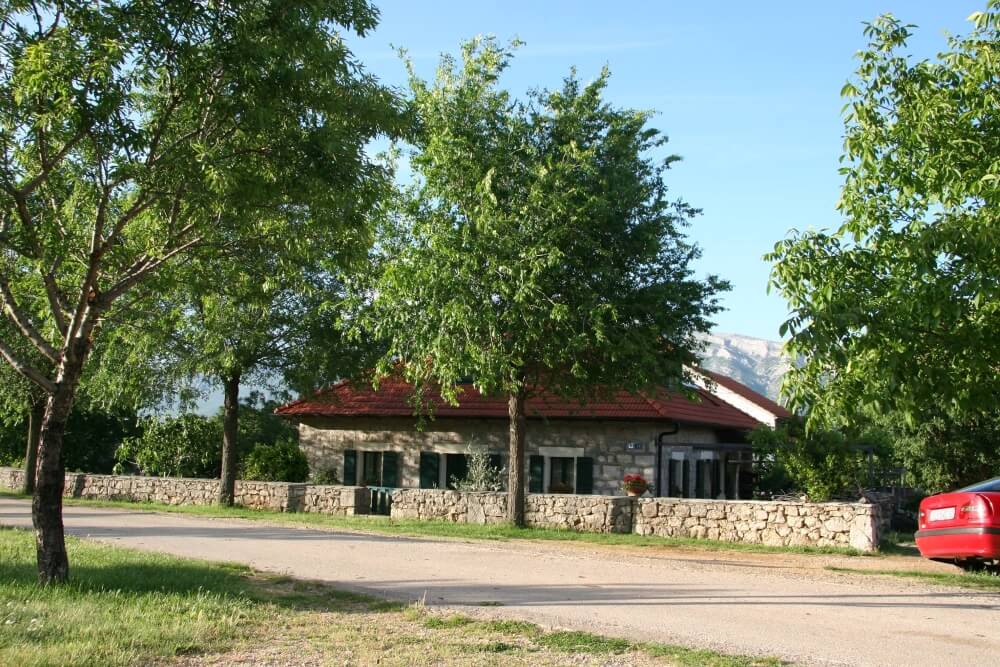
Significantly closer to the Izvor Cetina than many options, Stone house Cvitkovi dvori, is in the village of Kijevo. Actually, the Source of the Cetina is only around four km east of here. Also, this accommodation has great views and access to Dinara mountain and Nature Park. Not only do hosts Cvitko & Ljubica make a nice breakfast, but also you should try their homemade wine. Although their English is a telltale sign of years in the city, actually what they offer is a traditional village experience. Both the welcome and the ambiance will make you wish you’d booked another night. In detail, they have one apartment with a double and single bed. Also, two smaller rooms, each with two single beds. Therefore, they can comfortably accommodate groups of around 7.
Guest houses / Rooms in Knin
Although it’s just a couple of minutes walk from the centre and bus, Smještaj Ljiljana Bićanić is a quiet place to stay. Not only are the simple, clean rooms very affordable, but the hosts are friendly. Both homely and also simple, clean and extremely affordable, Sobe Nada Žunić in the centre has a famously warm welcome. Šime & Joso offer budget priced rooms above their popular pizza and peka restaurant in the city centre. Also, they can accommodate small groups of hikers.
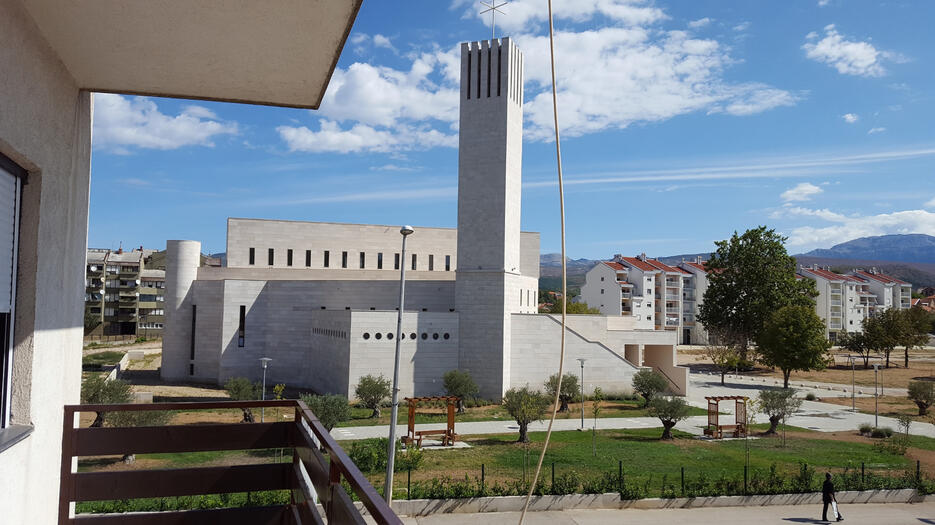
Not only do the spacious, clean rooms at Apartment Central have parquet floors, but also they are well equipped. Consequently, washing machine, balcony and AC here could easily facilitate a longer stay. Additionally, there’s Apartment Magdalena, Apartman Dida and Apartment Kastel, all within striking distance of the centre. So too, Apartment Ema & Mila, whose position just south of the River Krka and the city centre give a great fortress view.

Both convenient and centrally located, motel Tri lovca is right in the heart of town. Not only can you eat on the roadside terrace, but also they make popular pizzas.
Although the rooms at Rooms Mihovil are clean, small, functional, they are not this place’s best asset. Actually, the individual balconies with fantastic views are. But, these days, people only usually stay there if family members live there. (Because it has a residential home attached).
Camping in Knin
Although there are not yet any official campsites in Knin, that doesn’t mean there is no camping in Knin. Certainly, camping is a good way to experience Dinara Nature Park. Although, please remember the area is protected. Therefore, you must respectfully observe guidelines when camping.

The nearest campsite to Knin and Dinara is Camping Peruća, on Lake Peruća, in Garjak. However, that is not the only option. Actually, there are several mountaineering huts in Dinara Nature Park that offer basic, free accommodation overnight. Specifically, they are for walkers, hikers and those trekking or climbing the mountain. By all means, contact Knin Tourist Board or the local mountaineering association to arrange. Find out more about this offer and contact info in our Dinara Nature Park guide.
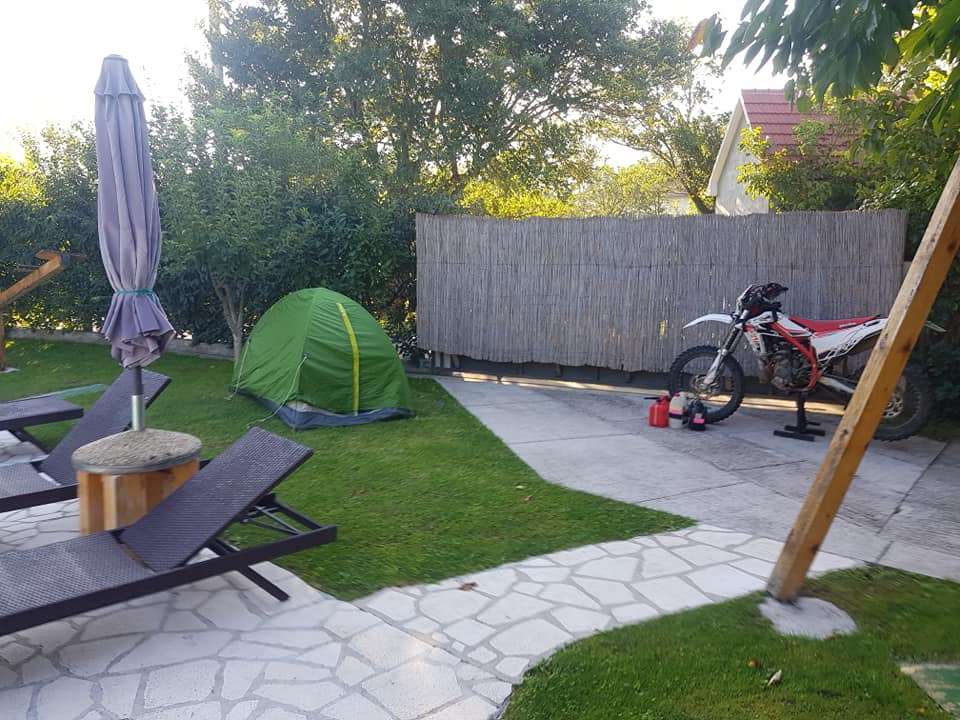
Important to realize, Knin is an extremely welcoming place for visitors. In fact, it is famous for its warm welcome to guests. Consequently, hosts can be very accommodating. Although not an official offer, some hosts have occasionally allowed camping in their gardens. Specifically, when helpfully trying to accommodate groups larger than the official capacity. If your group is slightly larger and some don’t mind a tent, then there’s no harm in asking.
Where to eat
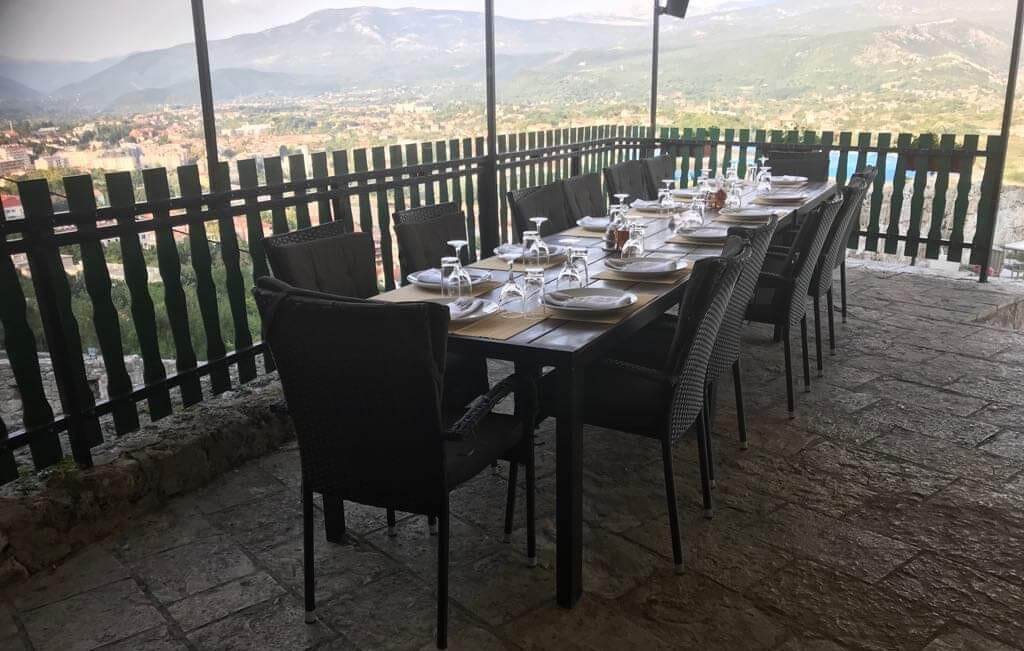
Restaurants in Knin
Restaurant Tvrđava

Not only is the Fortress among the city’s star attractions, but also it gives a major gastronomic highlight. Together with platters promoting the best local pršut and cheese, the main meals are excellent. Generally, it’s traditional, rustic fare – grilled and roast meats, pastas, steaks and salads. But, you can also get a great craft beer here. Not to mention the view from the restaurant terrace which is simply breathtaking. Subsequently, a meal here is simply a must.
Restaurant Tri lovca

Important to realize that with specialty roasted meats, once they’re done, they’re done. Obviously, it takes many hours of careful preparation and cooking to spit roast a whole animal. Indeed, lamb and suckling pig here are prepared in this way. Subsequently, the meat is left to rest, in order it retain its juices. Therefore, depending on when you arrive, your portion could be hot, warm or nearer cold. But, it will always be perfectly cooked. If you expect every meal to be served piping hot like back home, then order a pizza. However, if you want an authentic local food experience, order the lamb. But, adjust your priorities to taste, quality of meat and expert cooking, not to temperature.
Restaurant La Rossa

Previously, Knin was missing a classic restaurant experience in the city centre. But, in 2000, La Rossa arrived to remedy that. Of course, being of Italian inspiration, they do the pizza option. But, there’s a lot more here besides that. Both the pasta dishes and desserts are great and well presented. Also, they take advantage of the bounty from the nearby rivers. Accordingly, you’ll find fresh river fish on the menu here.
S’jela bistro

Although you can get other things besides, newest Knin restaurant S’jela bistro has an enticing USP. Burgers. If you want the best burger in town, then go here. Looking for a recommendation from their menu of 10 different burgers? Impossible. You’ll want to try them all.
Knin restaurants outside the city
Kod Pere in Radučić

If you’re a fan of rustic Dalmatian cooking, then seeing animals whole cooked from the road is an invitation difficult to pass. Not only is Kod Pere exactly that kind of place, but also they do it really well. Actually, they have a large area of seating indoors, popular in cooler months and for events. But, as a visitor, more likely than not you’ll sit in the informal, covered terrace.
Knin Pizza City

Point often overlooked, Knin is the pizza capital of inland Dalmatia. No, we’re not kidding. Not only will you find the best pizzas of inland Dalmatia here, but also it’s difficult to find a bad one.
Both peka and grill are available alongside the pizza at Konoba Šime i Joso. Also, Pizzeria Tenen who work every day from 7am to 11pm. Actually, Hotel Mihovil are locally known as much for their pizzeria and restaurant as they are their accommodation.
Great for weddings and events
Because of the large function room they have, Hotel Ivan is popular for weddings and parties. Correspondingly, they have their own Restaurant Ivan that does the food. Similarly, with a 400-seat capacity for banquets, Restaurant Kralj Zvonimir is also popular for events.
Top day trips
Krka National Park

A series of wide pools, fed by cascading waterfalls, Krka is one of Croatia’s best National Parks. Actually, the north of the park is only around 10km from Knin. If you want to take a boat to an island monastery or swim beneath waterfalls, then do it at Krka NP. Read all you need to know here.
Drniš

Although similar to Knin as a Dalmatian hinterland town, Drniš has a different history and offer. Not only is it home to Croatia’s most-distinct prosciutto (Drniš pršut), but also it’s the birthplace of world-renowned sculptor Ivan Meštrović. Actually, you can see lots of his work in the town. Read all you need to know about Drniš here.
Šibenik

Actually, only a few kilometres further on from Krka NP, you meet the sea. However, Šibenik is a city that has much more than just brilliant beaches. Additionally, it has 2 UNESCO World Heritage Sites and three impressive fortresses. You can learn all you need to know about it here.
Knin Weather
Knin has a modified Mediterranean climate. In general, it often shares the climate of the coastal regions just 50km away. However, the giant peaks of nearby Dinaric mountains have a significant, localised impact. Not only can Knin be hotter than the coast in summer, but also colder in the winter. Furthermore, in winter, snow often falls on the high areas. If you’re going walking or hiking around Knin, then, yes, you can safely do this throughout the year. But, always check the weather forecast first. Here’s how the weather in Knin looks today and the Knin weather forecast for the next few days.
!function(d,s,id){var js,fjs=d.getElementsByTagName(s)[0];if(!d.getElementById(id)){js=d.createElement(s);js.id=id;js.src=’https://weatherwidget.io/js/widget.min.js’;fjs.parentNode.insertBefore(js,fjs);}}(document,’script’,’weatherwidget-io-js’);
How to get to Knin and get around
Flights, nearest airport to Knin

Both Split airport and Zadar airport are near to Knin. Firstly, at 50 km distance, Split airport is the nearest airport to Knin. Although, it’s not much further to Zadar. The distance between Zadar airport and Knin is 70 km. Generally, it takes 70 minutes to get from Zadar airport to Knin. Similarly, it takes 70 minutes to get from Split airport to Knin. You can read all you need to know about Split airport here and Zadar airport here.
Knin Train Station

Not only can you get a train to Knin, but also it’s a great way to travel. There’s a train from Split to Knin. Also, there’s a train from Rijeka to Knin. And, a train from Zagreb to Knin. In fact, the Split Knin train runs on one of Croatia’s oldest train lines. Previously, they called this the Dalmatian railway. They built it in 1888. By comparison, the line running north is younger, built in 1925. However, this route is rather spectacular. Know as the Lika railway, the line runs through breathtaking mountain scenery. Doubtless, you’ll appreciate the views if travelling from Rijeka or Zagreb to Knin by train. Knin connects to the European train network through the international train hubs of Zagreb and Rijeka.
Road, by car to Knin

From Split to Knin by car
Not only is Knin to Split a good road connection, but also it’s an intriguing drive from each direction. If you’re travelling from Split to Knin, then you have two options. Firstly, the distance from Split to Knin on the D56 is 85 km. It takes around 1 hour and 30 minutes. Therefore, this is the quickest way to get from Split to Knin by car. Firstly, head out of Split towards the motorway. But, just after Klis, instead of going to the motorway, take a left onto the D56. Stay on the D56, passing Čavoglave. Afterward, look out for the turning on the right for Gradac and take it. Shortly, you’ll reach Gradac, where you take a left onto the D33. The D33 goes all the way to Knin.

Secondly, the other option is to take the D1. Following the same route out of Split, head for Klis. But, instead of turning off onto the D56, follow signs for Sinj. If you’re not in a rush, then this option has several advantages. Although it takes 1 hour and 50 minutes from Split to Knin on the D1, it’s a picturesque choice. Not only do you get to see Sinj (amazing), but also you follow the Cetina river. Indeed, Croatia’s third-largest lake, Peruća lines some of the route. Furthermore, the incredible source of the Cetina river itself is along the way. Both Sinj and the Cetina source are brilliant stop-offs for daytrippers. But, just make sure you leave enough time to see and experience everything Knin has to offer. Therefore, if you’re anywhere on the Croatian coast between Zadar and Split, Drniš is an easy reach.
Looking for a fast, reliable and trouble-free transfer to or from Knin? Contact TC transfer partner Adriatic Transfers for your one-stop solution.
From Šibenik to Knin by car
If you’re on holiday near Šibenik, then the link to Knin is evident. Because you’re staying in Šibenik-Knin County. Therefore, unsurprisingly, it’s no great distance between Šibenik and Knin by car. Following the D33 through Drniš is the best way by car. In detail, the distance between Šibenik and Knin on D33 is just 55 km and it takes 55 minutes to get there.
If you’re staying anywhere south of Šibenik, like Primošten, then do the same. Following signs for Drniš, then picking up the D33. However, if you’re staying in Tisno, Murter or anywhere more northerly, like Zadar, use the D59.
Bus to Knin

Travelling intercity by bus in Croatia is a fast, popular and reliable option. Indeed, you can easily reach Knin by bus from anywhere in Croatia. In detail, you can take a direct bus to Knin from Šibenik and bus to Knin from Split. Also, there’s a direct bus to Knin from Zadar and a direct bus to Knin from Zagreb. Learn more about travelling through the country by bus here.
More information
For more information about the city and its offer, visit the website of the Knin Tourist Board here: www.tz-knin.hr. They have contact details for all the activities and OPGs mentioned in this article.
Both the author of this article and Total Croatia would like to express their sincere gratitude to Mrs. Romana Marković and Tourist Board of Knin for their invaluable help in producing this Knin guide.
To follow the latest news from Knin, check out Total Croatia News.



